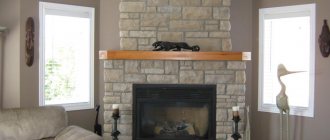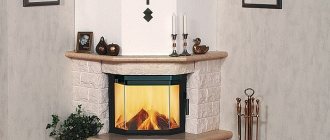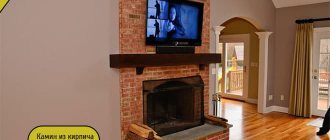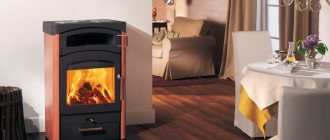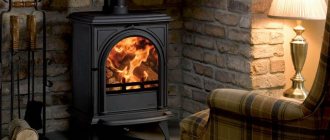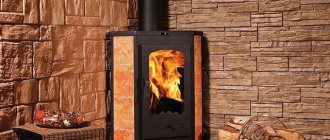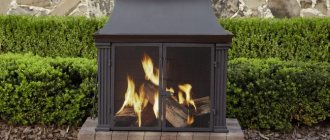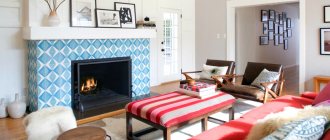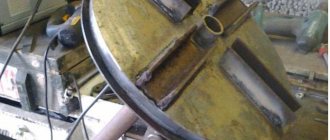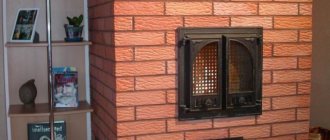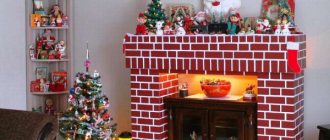A fireplace is a stone or brick structure in the wall, resembling a niche, which has a chimney to release combustion products into the atmosphere.
Corner fireplace
It is used as an element of the interior or for the purpose of heating a room (together with the main heat sources).
It is advisable to design and build a fireplace between two internal walls. When building a fireplace in the walls near the window, a draft (active air circulation) is formed, which contributes to the occurrence of drafts in the room.
General provisions and recommendations
To lay out a corner fireplace with your own hands conveniently and quickly, it is advisable to frequently check your actions with the order plan while working, and mark (number) the laid out rows with chalk.
The outer wall with the firebox should not be bandaged; this may lead to deformation due to temperature differences. Circular masonry
After laying out five rows, wipe the masonry with a wet rag or rag, removing any excess mortar that is squeezed out of the seams under the influence of the growing mass of the structure.
The inner surface of the firebox and chimney is not plastered! The slope of the rear wall is leveled by a steel screen that can be mounted into the masonry. The smoke collector vaults are laid out with gradual overlaps of bricks, about 5–6 cm for each subsequent row. The portal opening is covered with brick lintels laid in a circle. If provided, install a cast iron door.
During the production of work, the circle rests on the racks. After laying the castle brick, double (two-sided) masonry is carried out. The pipe is brought to the roof using the same solution that was used to lay out the base.
Methods for finishing fireplaces
If high-quality facing bricks were used when laying the external walls, then all that is required to improve the aesthetics of the structure is to fill the joints. To do this, they are rubbed down, and the outer surface is refined using a special tool - jointing. It is also necessary to sand the uneven bricks and coat the walls with a special compound. The simplicity of this method has a big disadvantage - over time, the surface of the fireplace darkens and loses its attractiveness.
A very simple way to improve the appearance of your fireplace is by plastering. Ready-made decorative compositions, which are presented in a wide range on the shelves of retail chains, are best suited for this. You can begin plastering work only after the walls of the fireplace have dried and shrink. If necessary, the portal can be painted with water-based paint, but this can only be done after the finishing layer has completely dried.
A fireplace trimmed with natural stone, as if taken from the era of knights and fair ladies
Currently, there are many options for covering a fireplace with materials of natural or artificial origin. Tiles will help make the stove bright and irresistible. They will completely transform the portal of the heating device, making it especially warm and homely. Finishing with marble slabs or stone, on the contrary, will create the effect of an expensive and presentable structure. As for facing the fireplace with ceramic tiles, you should choose only heat-resistant varieties - majolica, clinker, porcelain stoneware or terracotta. Of course, when laying facing materials, you should use only special, heat-resistant adhesives.
Chimney installation
Those who believe that the chimney is just a direct channel for the exit of flue gases should take a closer look at the diagram and order of the chimney, which experts recommend for equipping wood-burning stoves. Inside it is really a hollow rectangular pipe
As for the outer part, its configuration serves an important functional purpose
Design and arrangement of the chimney
The thickening at the intersection with the ceiling is called fluff. Thanks to several additional rows of bricks, it is possible to reduce the temperature of the flue gases so much that there is no need to install a heat-insulating layer. If you install a straight, thin riser, then the ceiling will have to be protected with several layers of asbestos or basalt slabs.
At the roof level, the chimney is expanded, resulting in a so-called otter. In addition to its aesthetic purpose, such widening also plays another, no less important role. When it rains, it is the otter that prevents precipitation from flowing down the outer surface of the riser, protecting the brick from destruction. As for protecting the smoke channel, for these purposes the top of the pipe is crowned with a metal cap.
Otherwise, when constructing fireplace chimneys, you must be guided by the same requirements as for other wood-burning stoves. The traction force, and therefore the performance of the fireplace, depends on the correct placement of the structure on the roof. You can familiarize yourself with the rules for installing a chimney by carefully studying the diagram below.
Chimney installation diagram relative to the ridge and roof of the building
Step-by-step instruction
In fact, laying a corner brick fireplace with your own hands is no different from conventional construction, with the exception of thin seams - the thinner they are, the better the fireplace will retain heat inside. To do this, the solution must be as homogeneous as possible and without lumps. The permissible thickness of stove seams is from 1 to 3 mm for the fuel compartment and up to 5 mm for the chimney and body. In this case, the seams must be filled completely.
9c30e4160462fcdd676ec568a005371b.jpe b19bba3a2edff27f03552cce3c2caf9b.jpe
7db3c80e09e5c5a58d5f0567b0acb269.jpe
e3b8c3ed590c247968f0e4bcee1ab44f.jpe
How to build a brick fireplace:
- The easiest and fastest way to build a fireplace is during the construction of a house, when interior decoration has not yet begun. The first step is to take care of a stable foundation, the dimensions of which should be 5 cm wider than the base row of the structure on all sides. Dig a pit of the appropriate size with a depth of 60 cm. If the floor level is located much higher than the surface of the ground, you just need to carefully compact the soil under the future fireplace and make formwork from wood. Coat the inside of the formwork panels with bitumen mastic or attach roll waterproofing (ordinary roofing felt will do just fine). Sheet iron can also be used to make formwork.
- Compact the bottom of the pit and pour a 10 cm thick layer of crushed stone or brick chips there, pour water on it and compact it thoroughly. The surface should be as smooth and horizontal as possible.
- Install the formwork on the crushed stone “cushion”, then put large stones or broken bricks (rubble) inside. There will be gaps between the stones, so add a little more crushed stone to fill them.
- Mix classic cement-sand mortar in a ratio of 1:3. First mix the dry ingredients, and then add water little by little, bringing the solution to the desired consistency (thick sour cream). Pour concrete into the formwork in a layer of 10 cm, level the surface and leave to dry for a day.
- The next day, again place a layer of rubble mixed with crushed stone on the dried concrete and fill it with concrete. Thus, bring the foundation almost to the level of the finished floor (5 cm lower). Carefully level the last layer of concrete, cover with polyethylene to prevent it from cracking, and leave to dry for 5-7 days.
- After the foundation has completely dried, dismantle the formwork.
- Cover the foundation with 2 layers of roofing material and begin laying bricks in accordance with the chosen order.
- Since bricks absorb moisture, they should be kept in water for 2-3 minutes before laying and applying mortar. If this is not done, they will take all the liquid from the clay mortar, and it will lose its strength and binding characteristics.
- When laying the basement row, install the bricks on the ribs. For the remaining rows, the bricks are laid flat. When the height of the structure reaches 25-30 cm, you can begin to form the walls of the combustion compartment.
- If the façade of the fireplace is not planned to be plastered or covered, when laying the front part, try not to bring the clay mortar to the very edge of the brick by about 5 mm - this will allow you to beautifully embroider the seams later. When starting to lay each row, check the horizontality with a building level, and the verticality with a square and a plumb line.
- When you lay out the firebox and smoke chambers, smooth and level the mortar not with tools, but by hand. This way you can feel and, if necessary, remove large particles and lumps in a timely manner, making the seams thinner. When you have completed 5-6 rows, wipe the inner walls with a damp cloth to remove excess solution - then this will be quite difficult to do.
- If you are bandaging the firebox masonry, the lining must be done separately without bandaging, so that temperature changes do not destroy the structure.
- If you remember, the rear wall of the fuel compartment and smoke collector should be inclined. To do this, lay each subsequent row with a slight overlap on the bottom one (4-5 cm). To prevent soot from accumulating on such a “ladder”, it is recommended to cover the masonry with a steel screen 3-4 mm thick.
- To make the ceiling of the portal, use a steel corner (you will need a fireplace lining) or a circle - a special formwork that allows you to create arched masonry. To do everything beautifully and correctly, first install the brick without mortar, evaluate the result, and only then lay it according to all the rules.
- When you bring the chimney to the roof, change the clay mortar to a cement-sand mortar - it copes better with atmospheric loads.
The design of a corner brick fireplace, no matter how simple it may be, requires utmost attention and skills in working with materials. If you doubt your abilities, it is better to entrust the work to a professional or at least enlist his support and recommendations.
Chimney and chimney
The chimney is a part of the stove, shaped like a cap, inside which there is a steel pipe (or ceramic chimney blocks), which turns into a smoke pipe. The back wall is made vertical, and the side walls are made tapering at an angle of 45-60 degrees. The internal cross-section is calculated according to the proportion: 0.1-0.15 of the portal area, and the height is made at least five meters from the fuel combustion surface. The walls are made thick enough to reduce heat loss.
A valve is installed at a height of about two meters. The frame for it is fixed with liquid mortar in the masonry.
The first point of installation of a chimney is installation above the smoke collector of the unit. Cement mortar is used to connect the openings of the pipe and the smoke collector. The brick lining is attached to the pipe by means of anchor joints inserted between the outer blocks of the pipe, which are embedded in the joints between the bricks. Internal surfaces must be free of gaps.
The pipe head is made at least 1 brick thick. To reduce the accumulation of condensate in the chimney duct and prevent fire of structures, install thermal insulation and thermal insulation.
Fireplace components:
- Chimney for fireplace.
- Support plate.
- Fireproof plate.
- The section where the pipe leads to the chimney.
- Firebox.
- To allow hot air to escape, install a ventilation hole with a grille.
- Decorative element and thermal insulation layer.
- Ventilation grille.
- A chamber with hot air, a ventilation grille, and the outside of the chamber is decorated with stone, marble and other materials.
- Facing.
- Movement of cold air.
A spark arrester and a deflector are installed on top of the pipe. The function of the spark arrester is fire safety. Structurally, this part is similar to a blank metal cone with wire mesh on all sides. The deflector is installed on the head in order to increase traction and protect the pipe from the wind. Typically the cross section of the deflector is circular.
Cladding of the fireplace and the protruding part of the chimney
If it was planned to leave the outer part of the fireplace brick, without additional cladding, then the masonry should be as neat as possible, and the mortar should not be brought to the front of the fireplace by 0.5 cm, so that it would be possible to expand the seams.
If the masonry requires additional decorative cladding, then artificial or natural stones, ceramic tiles, tiles and other materials are used. It is recommended to varnish the top of the stones to improve their decorative properties and facilitate maintenance.
The cheapest and simplest method of cladding, which is done after the masonry shrinks, is plaster. Using various spatulas, various decorative effects are created on plaster. There is a possibility of coloring the plaster.
Another popular way to cover a corner fireplace is to use plasterboard. It is cut and mounted on a special metal frame, strictly checking the corners and walls with a level.
DIY fireplace installation ↑
Construction of a fireplace is a multi-stage process, consisting of several stages, each of which requires utmost attention and responsibility.
If we talk about the correct technology for constructing stoves, it would not be amiss to note that the foundation for the fireplace should be made separately from the foundation of the main building. First, a pit is prepared, the dimensions of which are 10 cm larger than the dimensions of the future fireplace. The depth of the pit is 50-70 cm. The bottom is covered with a layer of crushed stone, after which the formwork is built.
Rubble stones are placed in the formwork, which are then filled with 3:1 cement mortar (sand:cement). The foundation is leveled, covered with plastic wrap and left to shrink for a week.
Waterproofing material must be laid in 2 layers on the foundation. Then the base is laid, and the bricks of the base row are placed on edge, while all the rest are placed flat. The brick is soaked in water for several minutes before use. This is necessary to achieve strong contact with the solution.
The laying of a brick fireplace is carried out according to a clearly drawn up scheme
If the masonry turns out to be inexpressive or brick defects are discovered, the stove can be plastered or any other type of cladding can be used, which will help hide the errors without expensive rework.
The method of laying the floor is of great importance for creating a cohesive composition. The firebox ceiling can become an original decoration. You can lay out the bricks in even vertical or horizontal rows, or you can create an arch effect. Gems, wood, and marble can serve well as additional decorative elements.
Laying a fireplace with your own hands
Wedge lintels are made of bricks laid on edge and aligned with the formwork. As a result, wedge-shaped seams are formed, the thickness of which should reach 3 mm, on top - 25 mm. Arched and radial lintels are laid on formwork that corresponds in shape to the given outlines. The laying of the lintel must be completed with a central brick, placed strictly in the middle and vertically, relative to the overall dimensions of the furnace.
A freshly laid fireplace is the result of work
Before starting laying, it is important to carefully study the diagram and think over the decor. It is difficult and often impossible to make adjustments to the completed order, because
changing the position of even one brick leads to a change in all rows.
A well-drafted plan that fully reflects the stages of work, thoughtful decor, high-quality materials and your desire - this is all that is needed to create an interesting fireplace that will become a worthy interior decoration, bringing warmth and comfort.
Preparation for construction
Selecting a location
The corner design outlines a very narrow range of possible options for placing the heating device - at the junction of the internal or external walls of the room. Nevertheless, the correct choice of installation location seriously affects both the ease of installation and the thermal efficiency of the unit during operation.
Most often, a fireplace is installed in the largest room - a living room or hall, since it requires a lot of air for its full functioning. The minimum requirement for room area is 20 square meters.
Experienced stove makers recommend installing a fireplace stove near the interior walls of the room. Otherwise, a drop in the thermal power of the heating device is inevitable, and problems with the functioning of the chimney are also possible.
The fireplace should not be placed opposite doors and windows, since when they are opened, a draft will form between the firebox and the open window (door) opening. In addition, it is necessary to comply with the condition of proximity to the roof ridge - this will greatly facilitate the process of building a chimney. In addition, a short chimney on the outside of the building looks more harmonious against the background of the roof.
It is imperative to pay attention to areas of the room that will come into contact with individual parts of the wood-burning heat generator. There should be no beams or rafters in the area where the chimney is installed, and support beams should not be laid under the wooden floor.
A fireplace with a closed firebox allows for constant draft regardless of the installation location. The operation of a heating unit with a cast iron cassette is almost never accompanied by the emission of smoke into the room.
How to build a foundation
The ideal option is to equip the base of the fireplace stove during the construction of the house. In this case, the slab can be filled with the same solution that is used for the construction of the strip foundation of the building. The only condition is that between the structures it is necessary to provide a gap of 5 to 10 mm wide. The fact is that the massive walls of the building will settle over time. At the same time, individual parts of the fireplace will also shift, and this is fraught with the appearance of cracks and tears in the walls of its chambers. To prevent this from happening, the foundation of the heating device is never connected to the foundation of the house.
A separate foundation for the fireplace is built even if it will be built during the construction of the building
If a fireplace needs to be built during repairs or reconstruction, then part of the floor will have to be removed. If a wooden flooring is installed in the house, then it is cut out at the place where the fireplace table is installed, leaving a margin of 10–15 cm in each direction. For these purposes, you can use either a regular hacksaw or mechanical tools - a jigsaw or a hand-held circular saw. In the resulting opening, they dig a pit with a depth of 0.5–0.6 m. It is convenient to carry out further work according to the diagram below.
- The bottom of the pit is covered with a layer of sand no more than 15 cm thick. After this, the bulk material is compacted using the tamping method, followed by spilling with water.
In sandy or sandy loam soil, the walls of the pit may crumble, preventing construction work. To prevent this from happening, the side surfaces are covered with plastic film.
- It is necessary to pour crushed stone 10–15 cm thick on top of the sand. In some cases, granite chips or broken bricks can be used.
- Strong wooden blocks are hammered into the corners, to which formwork boards are nailed. When performing this work, it is necessary to monitor the cutting of the top boards. They must be leveled as accurately as possible, since this affects the geometric accuracy of the structure.
If the formwork is made from narrow boards, then there will inevitably be gaps between them through which cement will flow out. It is very easy to avoid such a nuisance - just cover the walls of the wooden frame with plastic film or other waterproofing material.
- A reinforcement belt is installed at a height of 5–10 cm from the bottom. To do this, several metal pins are driven in, to which the construction mesh is attached with knitting wire. Another option is to install a reinforcing structure on the brick halves.
- By mixing crushed stone, sand and M-400 cement in a ratio of 4:3:1, concrete is prepared. If granite screenings are used, then its ratio to cement should be 3:1. Sand is not used.
- Concrete is poured into a mold and compacted by vibration, ramming or bayoneting. After this, the surface is leveled.
- Pre-hardening of the solution will end in 5–6 hours. After this time, the structure is covered with roofing felt and left for several weeks until the concrete sets completely.
Sometimes it is impossible to level the surface of the foundation due to the use of coarse crushed stone. In this case, the base is poured in two stages. First, the mold is filled 4/5 with concrete and compacted. The remaining 1/5 part is filled with ordinary cement-sand mortar. After this, bringing the surface of the foundation slab into proper shape will not be difficult.
Preparation of masonry mortar
Despite the fact that retail chains offer a wide variety of heat-resistant mixtures, experienced stove makers prefer the old, time-tested clay solution. For it, it is better to use high-fat clay, which is soaked 1–2 days before starting work. The resulting substance is filtered through a sieve, while kneading undissolved lumps. Subsequently, the uniform consistency will make it possible to lay brick on a seam of any thickness, up to the recommended 3 mm.
Sand is sifted through a sieve before mixing with clay pulp. Experts recommend using coarse river sand, but you can get by with regular sand, which is mined in quarries.
It is no coincidence that we mentioned that it is best to take fatty clay. The fact is that after drying it cracks less. If you manage to get blue clay, then know: there is no better material for laying stoves. At least, that’s what stove makers with extensive experience say.
Before you start laying, you need to determine the correct composition of the clay mortar.
Sand is added to the clay mortar immediately before starting masonry. Its amount depends on the fat content of the material, so to determine the correct proportion, use the following method: roll the solution into a sphere slightly larger than a ping-pong ball, and then place it between two even planks. Smoothly squeezing them together, watch at what moment the lump begins to crack:
- if the sphere falls apart almost immediately, this indicates an increased sand content in the solution;
- if the ball is compressed to half its diameter, and no cracks appear, then there is not enough sand in the clay mixture.
The ideal combination is considered to be the ratio that leads to the appearance of cracks when the lump is compressed by 1/3 of the diameter. Masonry should be carried out only with such a solution, otherwise there can be no question of any strength and tightness of the seams.
Finishing work
To be honest, I wouldn’t like to recommend anything in this section. Cladding a fireplace is a serious and difficult matter. Here you will need the services of a designer who will tie both the design of the fireplace and the design of the room into a single whole. After all, everything should be in harmony.
We just want to recommend materials that can be used for finishing work.
- If the brick from which you built the fireplace turns out to be without flaws, then we can assume that the finishing has already been done. True, during the construction process you will have to strictly adhere to a certain thinness of the masonry layer. You just need to grout the joints using a white solution. It's actually beautiful. By the way, here is a photo of a brick fireplace of this type.
Brick fireplace
Ceramic tile. Currently, this type of cladding has gained great popularity. Probably the fact is that ceramic manufacturers currently offer such a huge range that you can assemble heating devices and veneer them, knowing that there will never be the same brick fireplace. But you will have to take this point into account - not every ceramic tile can be suitable for finishing. First of all, it must be heat resistant. And this category includes: majolica, terracotta, clinker, tiles and porcelain stoneware. Stone. Whatever you say, the natural beauty of the stone is incomparable. It's not only beautiful, it's reliable, it's durable, it's powerful. In addition, stone will never go out of fashion, therefore, by lining the fireplace with it, you can change the interior of the room more than once. A stone fireplace will still fit in perfectly. True, this is the most expensive finish. And it doesn’t matter whether you use sawn wood or cobblestones. Although the market also offers a budget option - artificial stone. It is not as durable as natural, but in appearance it is not inferior to the latter.
Unusual finish
Positive sides
Illustrators often turn to scenes with wall-mounted fireplaces that touch one wall in the room. In fact, it is much more profitable to install a corner fireplace, since it is more ergonomic and fits into the interior of any room.
So, among the advantages of a corner fireplace, the following are noted:
- Serves as a reliable source of heat. It has superior heating properties to stoves and heaters.
- It occupies a smaller area, although in terms of appearance it is not inferior to the wall one and looks just as massive and solid.
- Suitable for installation both in a residential building and in a country house.
- In one hour of operation, a corner fireplace can heat a room with a volume of up to 120 cubic meters. m from 0 to 20 °C.
- It not only decorates the interior and warms the room, but is also suitable for cooking.
- This type of fireplace is considered safer than a direct wall-mounted one, since the flame inside the unit can be observed from anywhere in the room, and it has a smaller front wall area.
How to make a foundation for a corner fireplace?
Scheme of the foundation for the fireplace.
The base of the structure should not be connected to the foundation of a private house. There are 2 ways to build such a foundation.
047dfa09c1618a0860e146ab65c5f2f6.jpe 56023f8a7e4ff0921f5b99df5c10fa1c.jpe
The process of making a foundation in a house with a basement:
- First, you need to mark the depth of the structure being manufactured on the wall.
- At the mark location, you need to disassemble the flooring boards, and then move the marks below using a plumb line.
- The logs should not be dismantled until the base has been laid from the ground floor under the fireplace.
- Using a plumb line, you need to mark the exact location of the structure on the floor of the basement.
- The ground floor floor is broken down to the foundation.
- The soil is excavated to the base of the building. The dug hole should be 20 cm larger than the fireplace on each side.
- The base of the pit is carefully compacted.
- The foundation of the fireplace is being built. Between the base of the house and the foundation of the stove, you need to leave a gap of about 5 cm, which should then be filled with sand. The foundation is erected to the base of the first floor.
- Two rows before the base of the stove, a cement layer should be applied and several layers of roofing material should be laid on it to protect the structure from the dampness of the basement.
- Next, you will need to saw the logs that will be installed on the base of the fireplace.
- 1 more row of bricks is laid out.
If the building does not have a basement, then the foundation is made as follows:
Fireplace chimney diagram.
- You will need to dig a pit 15 cm larger than the foundation. If there is no underground water under the house, then you can immediately begin to make the foundation. If the walls crumble under the influence of groundwater, they will need to be strengthened.
- Next, the base is made. On the first floor you need to pour crushed stone into the hole and compact it thoroughly. Construction waste can be used instead of crushed stone.
- The formwork is being made.
- To isolate the base from moisture, the internal walls should be lined with roofing felt or coated with resin.
Foundation
A brick fireplace must be built on a solid foundation, but even the concrete slab that is installed for cast iron models will not work as such. Here it is necessary to build a full-fledged foundation with a foundation pit. It was necessary to think about this even when building the house. Therefore, if you decide to build a fireplace in a finished house, you will have to raise the floor in order to carry out work there.
An example of a well-made foundation
The area of the foundation pit should be slightly larger than the area of the fireplace body. The depth of the pit can vary in the depth range of 0.50-0.70 m. The exact value depends on the option and weight of the model.
Sand is poured at the bottom of the pit, and crushed stone is placed on top. To ensure that this composition is compacted tightly, it is watered with water. Metal structures are installed on top of the crushed stone, which will play the role of a reinforcing element. The foundation is poured in several layers. The bond between the layers is carried out with a special mesh. Using wooden formwork, the foundation is brought to the floor level. Once dry, it will be ready for construction of the fireplace.
masonry brick corner fireplace
A corner fireplace requires a separate foundation and a fireproof separation between the solid wood and the wooden surfaces. The separation is most often made from sheet metal or brickwork in a quarter of a brick.
osnovaremonta.ru
It is advisable to lay the fireplace according to the indicated drawings, observing the bandaging of the seams; there is no need to rush at all, the faster you lay the higher the chance that the masonry on fresh clay mortar will “float”. Remember the difference in masonry between a Russian stove built by a drunk neighbor and a fireplace for 80 thousand rubles. This is respect for horizontal, vertical and diagonal. If you do not have a trained hand and eye, check each brick with a level and keep the thickness of the seam to 4-6 mm around the entire perimeter. If you are not sure about something or have forgotten, you need to study the theoretical material of stoves and fireplaces.
Order of masonry
The order, façade and section are shown on separate pages. In order to arrange the corner fireplace, you will need to prepare a sheet of A4 paper in a box and a pencil.
This means using not only whole bricks, but also three-fours and halves. Accordingly, you will need to accept conventional images.
The base row of the fireplace is best made of brick, which will be placed on its edge - it will be more original, although this is not at all necessary. Next, the bricks (starting from the second row) are laid flat. The bottom of the stove firebox is often made 25-30 cm above the floor, which can be more comfortable.
Order of the corner fireplace:
From the sixth to the ninth rows, the laying of the firebox continues. Keep in mind that ceramic and fireclay bricks cannot be tied. Ideally, you should even leave a small gap between them so that the entire masonry is not damaged during operation of the fireplace due to the large temperature difference between the outside and inside of the fireplace.
- The first, second and third rows must be filled with bricks.
- The fourth row will be the hearth of the fireplace.
- In the fifth row, an ash pit is laid out. The support for the grate is formed using three steel strips (they are pressed against the masonry of the sixth row).
- A grate is placed in the sixth row.
- The bottom frame of the portal is placed in the seventh row.
- Rows from eight to thirteen will form the walls of the portal; the masonry is carried out with bandaging of the seams.
- In the eleventh row you need to start, and in the rest - continue to lay out the inclined mirror at the back wall.
- In the fourteenth and fifteenth rows it will be necessary to block the portal, continue laying and laying the mirror.
- In the sixteenth row the mirror laying ends. It is necessary to arrange the corner fireplace of the upper part of the tooth. On the chimney side, you will need to coat the tooth with a clay solution in order to provide protection against burnout.
- Next come the seventeenth to nineteenth rows, in which the façade is laid. The bricks need to be cut as shown in the section, towards the heil.
- The twentieth, twenty-first and twenty-second rows form a chimney 14x27 cm. The damper is installed in the 22nd row.
- The twenty-third row is next. The order shows that the smoke hole will be in the shape of a dovetail.
- In the twenty-fourth and all subsequent rows the chimney laying ends.
Elements required for making a corner fireplace
Only fireproof bricks should be used. Such a material can withstand temperatures of more than 1000°C, it will not deform when heated and cooled and can retain heat well. The material will need to be soaked in water to remove air from it. The brick can be used when bubbles stop coming out of it.
In order to make masonry mortar, you can use blue or red clay. For high-quality masonry of the fireplace, you need to add sand exclusively with small grains, cleaned of various contaminants. To carry out such cleaning, you should perform “elutriation”. The sand will need to be watered twice and then left to stand. The steps must be repeated until the water becomes clear.
Tools for laying a fireplace.
The base for the structure and the laying of the pipe are made of baked bricks, which are fixed with a mixture of concrete. To prepare a concrete mixture, you need to use M300 or M400 cement and clean sand with large grains. In this case, crushed stone can also be used. The ratio of sand and cement should be 3:1.
The fireplace is built using a clay mixture that is heat resistant.
First of all, you need to stir the clay in water until it reaches the consistency of thick sour cream. The clay should be left for several days. It needs to be mixed thoroughly every day. Next, the required amount of sand is added to the length. The main indicator of readiness is that the solution does not crumble and does not stick to your hands.
6995c1e8873ba664db062c4ad5cfc2d1.jpe d1a4310a85e822278c858d7e6a1a08ed.jpe
8b4e7cf22ad85e8b1aedc0d532e3ce5b.jpe
In the process of laying the first 3 rows of bricks, you will need to add a small amount of cement to the clay solution (3 parts cement to 10 parts mortar).
Elements you will need to build a brick fireplace with your own hands:
- Fire brick.
- Clay.
- Sand.
- Water.
- Cement grade M300 or M400.
- Crushed stone.
- Plumb.
- Building level.
- Trowel or trowel.
- Order.
- Shovel.
- Tamping.
- Ruberoid.
- Resin.
- Pencil.
Required tools and materials
After the paperwork is completed, you can proceed to purchasing the necessary materials. For convenience, break everything down into stages:
- Laying the foundation.
- Construction of the portal, combustion chamber and chimney part.
- Decorative works.
Everything for the foundation
- Waterproofing material, for example, polyethylene or roofing felt, for reliable protection against moisture from the soil.
- Medium grade crushed stone and sand to prepare concrete mortar.
- To install the formwork into which the concrete solution will be poured, boards or metal sheets are needed. If it is temporary and made of wood, then you will also need a gravel-sand mixture to close the gaps between the soil and the frozen foundation.
- Reinforcing mesh with a cross section of 8/10 millimeters
Possible foundation option for a corner fireplace
Walls and chimney
One of the most important materials in the work is fireclay brick
- Red burnt brick for the main masonry and fireclay for the combustion chamber and the initial part of the chimney. It is necessary to calculate the exact number of bricks. Most often, to build corner fireplaces you need about 360 to 600 pieces. But it is better to take 15% more for unforeseen circumstances.
- For bricklaying, it is recommended to purchase ready-made dry mortar. This is more convenient than looking for the right consistency of sand, clay and cement.
- Metal corners to cross the openings of the niches of the woodshed (if there is one) and the combustion chamber (40x40 mm or 50x50 mm).
- A wooden or metal template for a semicircular firebox niche.
- Minimum 5 meters of metal pipe for the chimney.
- Metal gate valve with extended handle. You can purchase it ready-made or use the services of a welder who can make one without any problems.
- If necessary, you can purchase a finished cast iron firebox.
- Asbestos sheets for wall insulation.
- Finishing materials are at the discretion of the owner: ceramic tiles, decorative plaster, etc.
- Stainless steel pipe gate.
List of tools for work
Tools for building a fireplace
It’s better to prepare all the necessary tools in advance so that you don’t have to run and search later, being distracted from your work.
- Sander.
- A pickaxe hammer for splitting bricks.
- Large trowel.
- Construction or laser level.
- Plumb.
- Cord for ordering masonry.
- Mallet.
- Rule for leveling foundation screeds.
- Various forms for water and solution.
- A corner so that the corners of the masonry are perpendicular.
- Shovel for mixing the solution.
- Decorative elements, if necessary.
For corner fireplace
As already mentioned, the order is a detailed diagram that indicates the position of each brick. In addition, ordering will greatly simplify your task and help you calculate the required number of bricks that you will need when building a stove or fireplace; moreover, you will be able to avoid unnecessary waste.
The arrangement of a corner fireplace is practically no different from the simple or classic version; you just need to take into account a couple of points. One of these important points is that the foundation should rise 10 centimeters above the floor. You can follow this procedure by following the instructions.
At the first stage, it is recommended to lay the foundation using clay mortar. Continue doing this until the fourth position (row), where you need to divide the fireplace into two blocks, covered by a stove.
Second phase. The first block should be designed as a niche for logs, and the second block as a front façade. At the next stage, it is recommended to use refractory bricks, and here you should form the base for the stove.
At the fourth stage, after covering the fireplace itself with a slab of solid metal, for example, steel, the construction of the fireplace should take place according to a pre-prepared scheme up to the twelfth row. In order for the entire heating system to work efficiently and without any failures, it is also better to use fire-resistant bricks for interior wall decoration.
At the next stage, it is necessary to continue laying, as at the beginning, according to a pre-prepared pattern until the twenty-seventh row. If you want to add extra rigidity, you can install iron corners between the bricks. They can be made by hand.
And finally, at the sixth stage, it is necessary to make valves on top of the building. The corner masonry of the fireplace differs in many ways from the classical one, but is not at all impossible.
7 photos
Preparatory stage
Before we begin construction, we will need to arrange the corner fireplace and a number of additional steps:
| Preparatory stage | Detailed description |
| Creating a Sketch | Arranging a corner fireplace requires careful preparation. At the first stage, you will need to prepare a high-quality and most detailed drawing diagram, which will display all the measurements, dimensions and other design features of your heating unit. If you have no experience in drawing up a plan, it is recommended to seek the help of a professional or take a ready-made project from this article or other online sources. |
| Choosing a location | The instructions or the so-called diagram should be drawn up based on the dimensions and features of the location chosen for installation and placement. Choose the largest and most spacious room, with good lighting, several windows and good ventilation. Please ensure that the selected viewing angle is as complete and advantageous as possible from the point of view of observing the fireplace and its operation. |
| Preparation and purchase of materials | After the stove diagram is fully approved, it is necessary to apply the main marks responsible for the width, height and depth of the structure on the walls and flooring. Then, if necessary, make certain adjustments. Next, all materials, mixtures, parts and fittings necessary for installation and construction are calculated. Since the work will be done with your own hands, purchase bricks and adhesive mixture with a small supply. |
It is interesting to know: a corner fireplace stove, which is made individually, despite the uniform operating principle of all wood-burning installations, may have visual and design features and differences. For example, the hearth can be either open or closed. It can be laid out with bricks or purchased already assembled. Such structures are made of steel and cast iron and are often equipped with fire-resistant transparent glass. For additional convenience, you can equip your stove in the lower part with a capacious firewood or ash chamber, in which all combustion products will accumulate, which are much easier to remove if this element is present. Niches and various shelves forming the shape of the structure form both a standard rectangular and elongated shape, and are made in the shape of a triangle, polygon or trapezoid.
Design features
The main elements of a corner fireplace are the fuel chamber and the chimney. The correct ratio of the sizes of these elements determines how efficient and productive the heating device will be. The base of the structure is called a fireplace table, which is located at floor level and rests directly on the foundation. A pre-furnace area is set up in front of the fireplace. It is laid out with refractory bricks and covered with ceramic tiles or metal sheets. According to fire safety standards, the platform must protrude beyond the portal by at least 30 centimeters on each side.
Construction of a corner fireplace - drawing
Above the fireplace table there is a place under which the firewood is stacked. The canonical design does not involve the installation of a grate, but it is often installed to increase the performance of the heating device. In addition, in furnaces with a closed firebox, bottom airflow allows you to regulate the intensity of the flame. Thanks to this, it is possible to extend the burning time of one fuel fill, and therefore increase the efficiency of the structure.
The firebox, like the firebox, is lined with fireproof materials—the temperature in this area often exceeds 1000 °C. Often, to enhance the heat-emitting ability, the back wall is lined with a stainless steel sheet or cast iron plate. To further enhance the heat transfer of the fireplace, the back of the firebox is tilted forward. This allows the thermal energy to be directed towards the floor.
A smoke collector (hailo) is installed above the firebox - a chamber in the form of a truncated pyramid with a small threshold in the front part. This barrier prevents cold air from mixing with combustion products and serves as an additional barrier to prevent smoke from entering the room.
141cc8140dd88f5e671dccc0611949e4.jpe
e524c06cee238a57416b70bf5c950629.xml 2c7f5e740c180404d6ed1e5c787e241e.jpe
On the back wall of the smoke collector there is a smoke (fireplace) tooth - a protrusion necessary for the formation of the so-called gas threshold. Thanks to it, it is possible to reduce the flow rate of burning gases and force them to remain in the combustion zone longer. The chimney tooth traps soot in the chimney, preventing it from falling into the combustion chamber. For this reason, a door for cleaning the chimney is often installed next to the brick ledge.
At the point of transition from the hayle to the chimney, a valve is installed, which regulates the draft. It also blocks the path of warm air from the room after the firewood has completely burned out.
The design of the pipe for removing combustion products is no different from the chimneys of other wood-burning stoves. To ensure good traction, the pipe is raised above the roof ridge, but not less than 5 meters from the hearth (grid).
Fire safety requirements for chimneys
The fireplace and its chimney are sources of increased danger. Therefore, compliance with fire safety measures is the main condition for their installation and operation.
- Areas of the floor, walls and ceilings in contact with the chimney are insulated with fireproof materials (metal, asbestos cement, plaster, basalt wool, etc.).
- The thickness of the insulating layer is at least 13 cm for sandwich chimneys and 25 cm for single-wall chimneys.
- A convection chamber with a thermal screen and ventilation vents is installed in the area between the cladding and the ceiling.
When operating fireplaces and chimneys, it is prohibited:
- Make kindling with flammable liquids and other flammable materials and substances.
- Use wood for kindling that exceeds the size of the combustion chamber.
- Use the chimney to dry clothes or shoes.Q = CA 2 g HT i − T e T i {\displaystyle Q=C\;A\;{\sqrt {2\;g\;H\;{\frac {T_ {i}-T_{e}}{T_{i}}}}}}
Laying a brick fireplace: where to start? ↑
The most common type of material for building a fireplace is brick. Fireplaces made of brick fit organically into any interior. The arrangement process, although it seems very complicated, with proper organization of the progress of work, is quite feasible with your own hands.
To simplify the task and coordinate the procedure, it is necessary to develop a laying scheme.
A correctly drawn up masonry scheme is half the success, because... it reflects all stages of work, which helps to avoid irreparable mistakes. The masonry diagram should reflect the order of the fireplace, step by step, sequentially. You can develop such a drawing (if you have a strong desire and relevant knowledge) yourself, or you can use ready-made samples, which, by the way, are abundant on the Internet.
The masonry diagram clearly reflects the progress of work
Here are a few more interesting options:
Fireplace arrangement - option 2
English fireplace arrangement - option 3
The masonry of stoves and fireplaces is most often made of solid clay bricks. However, it is also possible to use other heat-resistant materials, for example, refractory brick or stone. For the front surface, you should choose bricks of the highest quality, absolutely identical in size and color, with right angles and a smooth edge.
The manufacture of stoves and fireplaces requires a special solution. The mortar for laying a fireplace consists of cement, clay and sand. The cement content should be small and not exceed the required ratio: 1 part cement to 8 parts sand. First, dry sand and cement are mixed, and then clay is added. Complete homogeneity of the composition is necessary; the mixture should have a dough-like consistency, without lumps.
Project of a terrace with a barbecue attached to the house, photo
Terraces are classified according to several criteria: open, closed and semi-closed, attached to the house and free-standing, single- and multi-level. They can be made in different forms, at the main or rear facade, or completely encircling the house.
There are several styles of terraces that require the use of different materials:
modern style - composite materials, stone, iron and PVC;
Photo 1. Terrace attached to the house, made in a modern style. Divided into several zones.
traditional style - stone and wood, most often red or cedar;
Photo 2. Terrace made in a traditional style. The base of the building is made of mahogany, the barbecue oven is made of brick.
- colonial-style terraces are designed like classical architecture;
- beach style - the structure is made of wood painted gray.
Photo 3. Beach-style terrace. Made from wood painted light gray.
Barbecue ovens are made of brick, stone or cast iron. They are usually located near the wall of the house, closer to the kitchen. Each type has its own advantages and disadvantages.
Photo 4. An open veranda attached to the house with a barbecue oven and a dining area.
Photo 5. Possible project of a veranda with a barbecue for a bathhouse, measurements are indicated in centimeters and square meters.
To choose the right one, proceed from the size of the veranda; remember that in addition to the grill, you will have to place furniture: tables, chairs, possibly swings and other decorative elements.
Important! Building a veranda yourself will require a lot of effort, but you can do everything exactly as your soul asks. This will take a lot of time, a large selection of materials will be fraught with uncertainty, and in the absence of construction experience, some stages of construction will be very difficult
There are many different projects on the Internet. As a rule, these are projects of wooden verandas; their width varies (depending on the width of the house) and height: at ground level or raised. Choose according to your taste.
Dimensions to follow
The size of a corner brick fireplace is determined based on the heated area and its volume. In the example given in this article, we are talking about the area of the fireplace opening of 0.2–0.3 square meters. meters. You need to decide on the width and height of the fireplace combustion opening (firebox portal). For a small fireplace, the height to width ratio is 2:3. Thus, for our fireplace the portal will have dimensions of 56x40 cm.
The depth and height of the portal should have a proportion of 1:2–2:3
It is important to observe the dimension, since a larger depth will reduce heat transfer, and a smaller depth will provoke smoke. In the described case, the depth will be about 24–30 cm
So, we figured out the sizes. The dimensions of the chimney opening for the chimney are selected in accordance with the area of the opening of the fireplace part and should be from eight to fifteen times smaller than it. If the fireplace pipe is in the form of a rectangle, then in our case it will be 14x14 cm. If the fireplace pipe has a round cross-section, then its diameter should be 1-12 cm. The height of the pipe will be 3.5-4 m.
In order to increase the heat transfer properties of the fireplace, the back wall of its firebox is made with a forward slope, from a third of its height and beyond. A smoke collector is placed at the top of the firebox. Between these elements there is a cornice called a pass. The cornice prevents sparks, soot and smoke from being carried into the room.
When laying a brick fireplace, all its dimensions must correspond to the brickwork module. The dimension of the brick is 6.5 × 12 × 25 cm, the dimension of the masonry seam is approximately 0.5 cm. The firebox has the same dimensions as shown in the diagram of the corner fireplace in the figure below. (see Corner fireplace - dimensions)
Diagram of a corner fireplace. Firebox dimensions
The cross-section of the fireplace at the firebox level in plan determines the other dimensions. After we calculate them, we make layer-by-layer drawings of the order (masonry).
cbb2928978ded332c5c5bfcbb1a08379.jpe
Design
Sketch
Before starting all work, you need to understand for yourself what kind of fireplace you want. To do this, you need to choose the place where the future structure will be built and, looking at it, draw an approximate appearance of the structure. At this stage, think about brick cabinets on the sides, if necessary, a place for drying firewood or a ash chamber, a form of fireplace insert that can be bought ready-made from metal. It will have fireproof glass doors built into it. In general, try to depict the most accurate sketch of the project. This will make further work much easier. It is not necessary to have the skills of an artist or draftsman for this. This drawing will make it easier for you to create a detailed project plan.
This is how you can roughly depict the appearance of the future fireplace by hand
Ideally, you should start building it at the stage of building a house, for a more convenient opportunity to prepare the foundation for a future structure. But you can do it in an already finished house.
Very important! The foundation of the house and the base of the fireplace should not be combined with each other!
Necessary calculations
There are some requirements for a fireplace to function properly.
One of the possible options for a fireplace design is a drawing
- Good traction in the design is very important. And it can be considered good if there is no smoke in the room, heat does not escape into the chimney and the fire in the firebox can be lit quickly and without problems.
- High heat transfer is another important element. The room should heat up quickly if done correctly.
- A fireplace that is not in use should not remove existing heat from the home.
- When creating it, remember that it will become one of the main prides of your home. Treat its appearance as responsibly as its interior.
Let's take a closer look at what sizes of fireplace elements are most acceptable during its construction.
Firebox (table)
The view of the burning flame and heat transfer will depend on the correct size of the firebox. You can correctly calculate its size using the following formula: total area of the room/50=size of the firebox. The following table shows approximate parameters of the furnace section for small rooms.
| Room area (sq.m.) | Firebox size (cm) | Pipe hole size | ||
| Height | Width | Depth | ||
| 10 | 38.5 (5 rows of masonry) | 53 (2 bricks) | 1 brick | 140 X 140 |
| 15 | 46 (6 rows of masonry) | 66 (2.5 bricks) | 1.5 bricks | 140 X 270 |
| 20 | 53.5 (7 rows of masonry) | 79 (3 bricks) | 1.5 – 1.75 bricks | 140 X 270 |
The aspect ratio of width to height should ideally be 3:2, i.e. the width is a fraction larger. The depth of the firebox should be equal to 2/3 of the height.
Finished metal firebox equipped with a fireproof glass door
All these measurements have been experimentally verified and give the best result of the functioning of the structure. You shouldn’t increase or decrease them, thinking that it will be better!
Chimney
The correct functioning of the fireplace largely depends on the calculation of the size of the chimney. According to all the rules, if this element is round, it should not be less than 15 centimeters in diameter. If it has the shape of a square, then its size should be 1/10 of the size of the firebox. Its height must be at least five meters.
Tips before installation
Regardless of the shape of the corner fireplace, it is recommended to include its presence in the house design. The work is classified as dirty, as there will be a lot of dust and debris. It is also necessary to solve such problems as dismantling the existing floor surface and attaching it to the rafters and beams.
Only after the reinforced foundation has hardened will it be possible to begin laying – this will take 3-4 weeks. Each row performs a specific role, so its installation is handled judiciously and with maximum responsibility.
When building a corner fireplace in a wooden house, it is necessary to cover the surfaces with non-combustible insulation. The gap between the back wall and the wall itself should be at least 1.5-2 cm
to prevent fire. By increasing the space to 4-5 mm, you can not resort to thermal insulation, but it is not recommended to neglect it.
